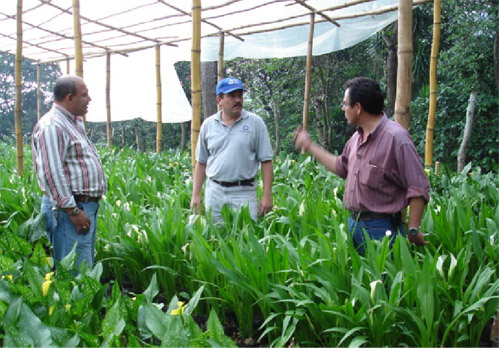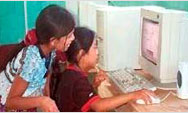You are here » Home » Telling Our Story
Success Story
Meeting demand for floral bouquets with locally grown flowers
Farmers Color Fields with Flowers

| |
Photo: Winrock Internationa/Estrella Chavez
|
|
José Magaña, right, shows his new flower crops near Sontecumat, western El Salvador, to USAID partners Ricardo Hernández, center, of Winrock International, and Edgardo Molina of Technoserve.
With help from the USAID-sponsored Farmer-to-Farmer program, Salvadoran farmers are learning to tap into a fast-growing local demand for fresh-cut flowers.
|
Farmers in El Salvador are combating a slow economy with a unique tool: flowers. With help from USAID’s farmer-to-farmer program, Salvadoran farmers are learning to tap into a fast-growing local demand for fresh-cut flowers.
The Salvadoran cut flower market grew 15 percent annually between 1999 and 2005. Yet despite booming demand and an excellent climate for floriculture, 40 percent of fresh-cut flowers sold locally are imported.
José Magaña, a farmer near a small town called Sontecumat in El Salvador’s western Ahuachapán region, said the downturn in the economy made it necessary to look for creative ways to make ends meet. “I started to investigate different programs of agriculture diversification,” he said. While looking for alternatives, José found the Farmer-to-Farmer program, which requested a volunteer to come and help José and others like him learn about floriculture.
Volunteers Richard Evans from California and Martin Connaughton from New Mexico came to Ahuachapán and began helping José and other farmers identify flower varieties that would thrive in the region’s climate and farm conditions. They helped farmers build low-cost greenhouses with local materials like bamboo and taught them techniques for bulb planting, soil management, and curing bulb bacteria.
Today, José Magaña’s farm is producing 40 dozen specialty cut flowers weekly, which he sells to local flower shops for $6 a dozen. In addition, José has hired 11 full-time workers. When he recovers his initial investment in 14 weeks, he plans to purchase more bulbs and build another low-cost greenhouse where he can produce flowers year-round. Due to the success of the project, it is being replicated by other farmers in the region.
The USAID-funded Farmer-to-Farmer Program has helped farmers, producers, associations, and cooperatives in El Salvador raise incomes and create jobs for hundreds of Salvadorans.
Print-friendly version of this page (439kb - PDF)
Click here for high-res photo
Back to Top ^ | 

